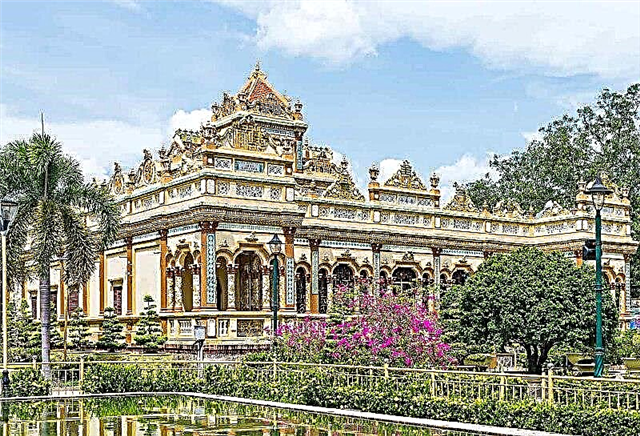Since 1970 Rostov the Great has the status of a city-reserve. This is no coincidence, because ancient Rostov is one of the oldest Russian cities, the history of which has exceeded 1000 years... A little more than 30 thousand people live in Rostov today. It is located on the route of the "Golden Ring" of Russia, annually receiving thousands of tourists, as well as pilgrims who come to venerate the Rostov shrines.
Content:
sights
The history of the emergence of Rostov the Great
From time immemorial, the ancient Finno-Ugric tribe Merya lived on the Rostov land, which was peacefully replaced by the Novgorodians who came to the shores of Nero. Already in the 10th century, Rostov turned into a large city, which for several centuries remained the capital of a powerful appanage principality on the northeastern borders of the nascent Russian state. His possessions were large and extended to Novgorod itself. And the power was so great that the Rostov princes minted their own money.

Spaso-Yakovlevsky monastery
When the Tatar-Mongols attacked Russia, they took Rostov without a fight, because the city was not equipped for a serious defense. And this saved the city buildings from destruction and plundering.
From the 15th to the 17th century, the city became the center of religious life for all residents of the Rostov lands. Monastic cloisters, temples were built here, and their own metropolis was created. And only the Time of Troubles briefly plunged the city into the abyss of ruin and misery. After them, trade and the merchant class began to develop actively in Rostov. And the local fair was recognized as the third most important in Russia.
Architectural sights of Rostov the Great
The recognizable calling card of Rostov has become its ancient Kremlin, with five temples around which powerful defensive walls rise. This architectural ensemble, like the entire city, stands on the shores of the largest natural reservoir in the Yaroslavl region - Lake Nero. On the territory of the Kremlin there is a magnificently beautiful stone Assumption Cathedral, built on the Rostov land at the beginning of the 16th century.
In addition to the Kremlin complex, more than 300 historical and architectural monuments are protected in Rostov, a third of which have federal status. The city is revered by believers as one of the centers of the spread of Orthodoxy in Rostov-Suzdal Rus. Therefore, pilgrim tourism is developed here. Groups and individual travelers love to visit Rostov monasteries and temples associated with the names of revered saints - Sergius of Radonezh, Abraham, Jacob and Dmitry of Rostov, Peter Ordynsky, Irinarch the Recluse and Blessed Isidor.

Rostov Kremlin
And despite the devastating years of the struggle of the Soviet regime with religion, the efforts of ascetics - believers and museum workers in Rostov managed to preserve many Orthodox shrines - the relics of preachers, ancient icons, skillfully made altars and crucifixes.
In addition to the monuments of cult architecture, earthen ramparts have been preserved in Rostov the Great, poured in the 30s of the 17th century around the historical part of the city for defensive purposes. Here you can also see the stone buildings of the old trading rows, erected in the XVIII-XX centuries. On the city streets there are many stone civil buildings dating back to the 19th - early 20th centuries, and several old city estates that belonged to eminent Rostov merchants.
Rostov traditions and brands
More than a dozen museums welcome guests in Rostov. There are also museum expositions in the nearest suburbs - in the village of Borisoglebsky and the village of Bogoslovo. Most of them talk about the ancient traditions of the Rostov land, the customs of its inhabitants, that is, about what makes Rostov the Great recognizable and memorable.
A story about the famous Rostov bells awaits travelers in the museums of the Rostov Kremlin. Here you can see the giant 32-ton bell "Sysoy", cast in 1689, and hear the low twang it emits. The loud polyphony of the city belfry is known far beyond Rostov, and its bell ringers are considered the best in Russia. Harmonious chords have been considered the reference by all Russian bell manufacturers for many centuries. Many scientific works are devoted to the study of these wonderful measured sounds.

Avraamiev Epiphany Monastery
They have been transcribed into sheet music and, in ensemble performance, have repeatedly filled concert halls and open-air venues. And, of course, bells are traditionally sounded during divine services.
The inhabitants of the city and the surrounding villages of Nero are famous for their vegetable gardens. It is not for nothing that the Rostov land is called the birthplace of Russian truck farming. Onions will be born especially well on the local soil fertilized with sapropel from the lake. A whole museum "Lukova Sloboda" was even dedicated to him. Here you can find out that reverence for the gardening talent of the inhabitants of Rostov appeared a long time ago. They were invited wherever it was necessary to develop gardening traditions, and even abroad. Interestingly, during the reign of Peter I, Rostov gardeners were the first in Russia who began to grow medicinal herbs in their beds - mint, tarragon and sage.
The inhabitants of Rostov also became famous as skilled artisans. The beautiful wooden church of St. John the Theologian, built at the end of the 17th century, has become a real monument to local carpenters. It is located just 3 km from the city, on the Ishne River.
The original craft of artistic enamel began to develop in the Rostov land. It consists in applying a very strong glassy coating to a metal object, which is then fired. Colorful enamel souvenirs and jewelry today are the most coveted souvenir brought by travelers from the ancient city.

Church of the Savior on Torgu
There are two museums dedicated to the famous enamel industry in the city. One of them is located in the Rostov Kremlin, and the other is at the Rostovskaya enamel factory.
Tourist infrastructure
In a city small in size and population, more than 20 hotels have been created for tourists. And besides this, travelers are happy to host several hotels in its immediate suburbs. Therefore, having arrived in Rostov the Great to see the sights of the "Golden Ring" of Russia, you can take your time and safely stop in the city for a few days.
The level of service in Rostov hotels is different. But, focusing on information and reviews on the Internet, it is easy to choose the right option for yourself. There are several hotels that host Orthodox pilgrims, as well as inexpensive hostels. Rostov hotels often offer bicycles for rent. And given that the terrain in the city is flat, this is a very convenient option for moving around the streets and exploring local monuments.
Finding a place where you can eat is also not difficult in Rostov. There are many restaurants in the city specializing in traditional Russian cuisine. For example, "Moscow tract" (Okruzhnaya st., 29A), "Teremok" (Moravskogo st., 1), "Slavyansky" (Sovetskaya square, 8) and "Rastegay" (Kamenny most st., 4). There are even more budget cafes, coffee shops, bars and pizzerias in Rostov. In addition, in some monasteries, for example in Spaso-Yakovlevsky Dimitriev or in Trinity-Sergiev Varniev, you can always eat tasty and inexpensive food in the monastery refectory.

Church of the Ascension
It is easy to organize sightseeing of Rostov attractions on your own. All of them are not too far from each other, so it is not difficult to get around the main temples, monasteries, museums and memorial sites on foot or using the services of public transport. And even more so, no problems arise if you come to Rostov the Great by your own car.
For convenience, if you wish, you can use the services of many Rostov travel agencies that organize excursion programs in the city itself, in its suburbs, as well as on Lake Nero. Their offices are easy to find near the city railway station and on the territory of the Rostov Kremlin.
How to get to Rostov Veliky
By car. The federal highway M8, connecting Moscow and Arkhangelsk, leads to Rostov the Great. From the capital to the city - 220 km, and from Yaroslavl - 55 km.
On your own by train and bus. It is convenient to get from the capital to Rostov by Yaroslavl express trains. They depart twice a day - at 8.20 and 16.20. In addition, you can buy a ticket to Rostov for any long-distance train passing through it. From Moscow, these are trains going to Kostroma, Vologda, Kotlas, Syktyvkar, Vorkuta, Khabarovsk, Arkhangelsk, Chita and Severodvinsk. From the Yaroslavsky railway station in Moscow to Rostov, the train takes about three hours. In Rostov Veliky itself, the railway station is located not far from the city center.

Rozhdestvensky monastery
In addition, you can get to Rostov by bus. In Moscow, regular buses leave from the central bus station, located near the Shchelkovskaya metro station. There are also buses to Rostov that go to Yaroslavl, Rybinsk or Kostroma, the route of which starts from the VDNKh metro station. The journey takes about 3.5-4 hours.











